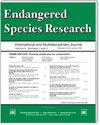A review of the conservation status and survey methods for the live-bearing sea star Parvulastra vivipara
IF 2.9
2区 环境科学与生态学
Q2 BIODIVERSITY CONSERVATION
引用次数: 0
Abstract
ABSTRACT: The live-bearing sea star Parvulastra vivipara, 1 of only 6 Asteroidea species globally that gives birth to live young, had an uncertain conservation status due to data deficiencies and historical differences in research methods. Restricted to southeast Tasmania, its distinctive reproductive strategy, coupled with limited distribution, low genetic diversity, and geographically isolated populations makes P. vivipara populations highly susceptible to localised and global extinction. Since the species was described in 1969, ten different historical survey methods have been used to survey P. vivipara populations. Notably, the survey area at these locations has increased through time as P. vivipara abundances declined. In 2022, surveys revealed the persistence of P. vivipara populations at 10 of 15 historically documented locations. Five locations experienced local extinction of P. vivipara populations, 3 in the last 2 decades, and 4 locations had <150 individuals remaining. P. vivipara density has experienced a decline of 90% from the first surveys in 1974-2001 to recent surveys in 2022. Based on the current trajectory, it is predicted that the density of P. vivipara will decline to 1 ind. m-2 by 2033 and 1 ind. site-1 by 2111, with some locations experiencing this decline even sooner. The rapid decline and restricted area of occupancy mean that P. vivipara qualifies for Critically Endangered status under IUCN Red List criteria A1 and B1. There is a pressing need for standardised and ongoing monitoring, management of key threats, and recovery strategies to bolster local and global P. vivipara populations against the threat of extinction.活体海星 Parvulastra vivipara 的保护现状和调查方法综述
摘要:活体海星(Parvulastra vivipara)是全球仅有的 6 个能产下活体幼体的星形目物种之一,由于数据不足和研究方法的历史差异,其保护状况尚不确定。vivipara 局限于塔斯马尼亚东南部,其独特的繁殖策略、有限的分布、较低的遗传多样性和地理上孤立的种群,使得 P. vivipara 种群极易在局部地区和全球范围内灭绝。自 1969 年描述该物种以来,已经使用了 10 种不同的历史调查方法来调查 P. vivipara 种群。值得注意的是,随着 P. vivipara 数量的减少,这些地点的调查面积也随之增加。2022 年,调查显示,在 15 个有历史记载的地点中,有 10 个地点的 P. vivipara 种群持续存在。有 5 个地点的 P. vivipara 种群在当地灭绝,其中 3 个地点是在过去 20 年中灭绝的,4 个地点的 P. vivipara 种群仅存 150 个个体。从 1974-2001 年的首次调查到最近 2022 年的调查,维维巴拉鱼的密度下降了 90%。根据目前的轨迹,预计到 2033 年,P. vivipara 的密度将下降到 1 ind.这种快速下降和有限的栖息地意味着,根据世界自然保护联盟(IUCN)红色名录标准 A1 和 B1,P. vivipara 属于极度濒危物种。目前迫切需要进行标准化的持续监测、对主要威胁进行管理并制定恢复战略,以支持当地和全球的维氏豹种群抵御灭绝的威胁。
本文章由计算机程序翻译,如有差异,请以英文原文为准。
求助全文
约1分钟内获得全文
求助全文
来源期刊

Endangered Species Research
BIODIVERSITY CONSERVATION-
CiteScore
5.50
自引率
6.50%
发文量
38
审稿时长
31 weeks
期刊介绍:
ESR is international and interdisciplinary. It covers all endangered forms of life on Earth, the threats faced by species and their habitats and the necessary steps that must be undertaken to ensure their conservation. ESR publishes high quality contributions reporting research on all species (and habitats) of conservation concern, whether they be classified as Near Threatened or Threatened (Endangered or Vulnerable) by the International Union for the Conservation of Nature and Natural Resources (IUCN) or highlighted as part of national or regional conservation strategies. Submissions on all aspects of conservation science are welcome.
 求助内容:
求助内容: 应助结果提醒方式:
应助结果提醒方式:


